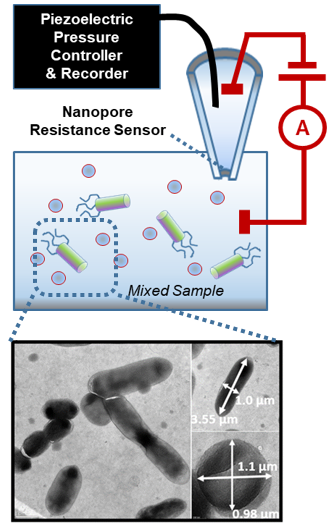Nanopore Sensor to Characterize Nano and Microscale Particles and Cells
Background
Detecting and measuring analytes or organisms in a mixed solution is needed in numerous applications such as flow cytometry, DNA sequencing, sensing of protein folding, sub-structural analysis, drug binding or vesicle sizing. Techniques for such applications are often limited by speed, accuracy, sample size as well as the need for secondary stains or labels. Direct assay of very small objects in their native state, especially in a mixed solution, needs a better solution.
Brief Description
Researchers at the University of California, Riverside can discriminate between mixed populations of cells and particles in solution using pressure to displace objects across a nanopore multiple times. Ionic current flow through the nanopore indicates the pressure required to translocate the object in the pore, which correlates to the object’s mass and volume. Key to these results is that a nanopore sensor allows pressure oscillations to capture and release repeatedly the same object to learn about its inertia and morphology. Such data can provide details about the size and shape of analytes, their morphologies and structural constraints, or even pathological conditions of living cells.

Fig. 1 Nanopore sensing of differently sized cells in a mixed bacterial culture.
Applications
- Characterization of mass, size, volume, density, concentration and/or morphology of an analyte such as a single cell or single particle.
- Discriminating, sorting or adhesion rupturing populations of analytes in a mixed sample.
- Assessing compound or drug loading and/or release from vesicles including liposomes, particles or micelles.
- In-line monitoring of the manufacture, state of synthesis or morphological changes of an analyte
Patent Status
| Country | Type | Number | Dated | Case |
| United States Of America | Issued Patent | 11,994,484 | 05/28/2024 | 2020-240 |
Related Materials
Contact
- Grace Yee
- grace.yee@ucr.edu
- tel: View Phone Number.
Other Information
Keywords
analyte multi-pass measurement, density, morphology, assay, nanopore, particles, cells, mixed populations
